► Racing with Sir Chris Hoy in the Sports Prototype Cup
► CAR shadows – and drives alongside – the Olympic hero
► Crashes, podiums, psychology lessons… It was a busy weekend
Sir Chris Hoy is one of the most famous sportspeople in the country. The year he won three Olympic gold medals at Beijing, he reportedly shook hands with an average of 200 people a day and occasionally had to wear a disguise to go to the supermarket unbothered. But the world’s most successful ever track cyclist is also a massive petrolhead, and a thoroughly down-to-earth one at that.
We’re in the paddock at Norfolk’s Snetterton circuit, chatting about cars and motorsport. Hoy – undisguised, aside from the facemask compulsory at all UK race meetings at the moment – is still buzzing from recent competition in the British Rallycross Championship. ‘Let me show you the video – the acceleration, the sound of the anti-lag, it’s ridiculous…’
His daily driver is an Audi RS6, and his other car actually is a Porsche; a GT3 RS (with the Weissach Pack, Manthey suspension and braided brake lines – he tracks it regularly), plus a Caterham 420R. Yep, proper car guy.
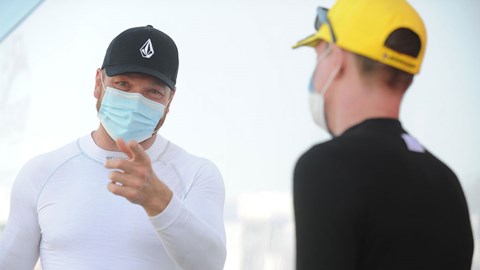
We’re also in the middle of a race meeting ourselves. It’s the third round of the 2020 Sports Prototype Cup, and Sir Chris is here racing the ferociously quick Revolution A-One. And, counting its lucky stars, CAR is racing a Revolution too.
You might remember reading about the Revolution last year, when we raced the British race car constructor’s first production car at Donington Park. You can read about the A-One and its background in detail at the link here but a quick recap:
The Revolution A-One is a prototype-style sports racing car, clothing its carbonfibre monocoque chassis with high-downforce aerodynamic bodywork. Take the upper body panels off and it looks like a very wide open-wheeler formula car, with a big front wing, a boat-like keel ahead of the driver’s feet and a serious rear diffuser. Power comes from a 3.7-litre Ford V6, with big torque and a long life between rebuilds, ideal for endurance racing. All that downforce means lap times approaching those of GT3 racing cars and not far off LMP3 prototypes. It’s easily the fastest car I’ve raced. It costs £139k ex-VAT; not small cash, but commensurate with the performance, and balanced by being designed from the outset for the lowest possible running costs. In the UK, it races in its own class in the Sports Prototype Cup, alongside other categories for various low-lying, fast-lapping projectiles.
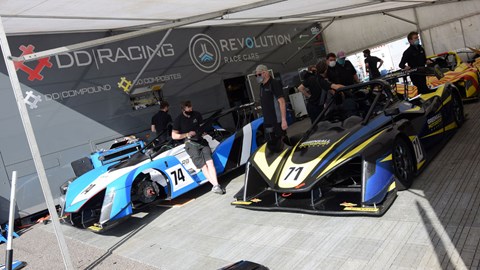
Since our first meeting with the Revolution 18 months ago, when it was still at base camp of its potential curve, things have developed apace. The car has had a variety of technical upgrades, chassis number 19 has recently been completed, and the one-make Revolution Trophy will be supporting the Portugese F1 Grand Prix, no less, with two races between October 22-25 at Portimao. Around 20 A-Ones are expected to be on the grid, with Sir Chris among the drivers competing.
He’s getting some track time in at the Sports Prototype Cup round at Snetterton to prep for Portimao, and when an opportunity presented itself for CAR to compete in the same class and shadow him for the weekend, we’d have been mad to pass it up. Chris’s car is being run by the ExcelR8 team, and I’m being run by the excellent Greensall Motorsport, an outfit that competes in all corners of the motorsport kingdom, from historics to rallying to prototype racing. Our two cars are being prepped alongside each other in the same awning, so I’m kind of, sort of, in a way, Sir Chris Hoy’s teammate for the day. And I don’t even need to wear a skinsuit.
Friday: Practice
Since we first met the Revolution, its 3.7-litre Ford V6 has gained another 50-60bhp, thanks to new cams and valvetrain and higher compression, so it’s getting on for 400bhp in a car that weighs less than 800kg. It didn’t exactly feel short of power before. That’s brought home when accelerating out of the pitlane for the first time on cold tyres, I find myself pointing at the barrier for a split second, arms crossed in opposite lock. No traction control. I’m awake now.
When I swap notes with Chris afterwards, turns out he had exactly the same moment. That makes me feel better. I haven’t raced since the first outing in the Revolution 18 months ago and I’m very rusty, but I chip away at both the rust and the stopwatch, build up slowly and by the end of the day I feel up to speed. Chris and I are running similar laptimes, which is encouraging.
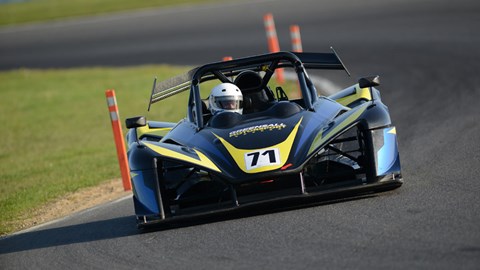
Chris is encouraging full stop. Several of the other drivers here raced with Hoy in his first season of racing as a guest driver in the Radical SR1 Cup, and there’s great camaraderie between them. Hoy’s cycling teammates have spoken of how he treats everybody as an equal, and he’s seemingly the same in the motor racing paddock. There’s no ego on display, and when he asks competitors how they’ve got on or wishes them luck, you sense he’s genuinely willing them to do well.
‘I’ve always tried to be a good competitor,’ he says, when I ask him about his cycling victories (see the foot of this page for the CAR Q&A). ‘Obviously you want to win, but you do it the right way.’
Aside from being Britain’s joint most precious-metalled Olympian (six golds, one silver), he’s now well-known for being a seasoned racing driver, with success at Le Mans and beyond. Former Team GB teammate (and subsequent Tour de France winner) Geraint Thomas has spoken with awe of Hoy’s absolute commitment to training and preparation. But motorsport, Chris says, is a discipline that requires you to relax a little – to accept that not everything is within your control.
‘For me, confidence comes from preparation. Being prepared takes pressure off you. So when I started in motorsport, I found it quite stressful. I was used to putting in 35 hours a week of riding, 52 weeks a year; in car racing, you can have an issue with the car in practice, then be straight out into qualifying having barely completed a lap. So I’ve learned to go with the flow, and understand that some things are beyond your control. It’s about concentrating on the things that you can have control over.
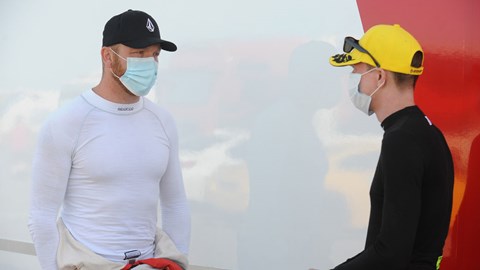
‘All through my motorsport career, something often seems to go wrong early on in the weekend and I’ve been on the back foot in the race. It’s nice to have people congratulate you on comeback drives through the field but it would also be nice every so often to have a trouble-free run…’
Are there any approaches from cycling that can be directly transferred to driving?
‘The faster you move, the more you have to think ahead and look ahead but I think it’s the mindset more than the physical process. It’s your attitude; sports people are used to having a go, and thinking “what information can I use to get to that goal?”’
That, and laser-guided focus:
‘So many distractions can affect you when you’re racing,’ he adds. ‘I haven’t been in motorsport all my life, so it’s not second nature to me like some pro drivers: I’m constantly thinking to myself, ‘brake hard here, bleed the pressure off the pedal now, and so on.
‘Steve Peters [Team GB sports psychiatrist] says you can’t NOT think about something; if someone says, “don’t think about a pink elephant,” an image of one probably pops into your mind. So when I’m racing, I say to myself: “All I’m thinking about in the world is this track and this moment now.”’
Saturday: Qualifying
I try and take that advice on board for qualifying, and do just that. The Revolution is sensational to drive. Tons of torque and likewise downforce: your neck muscles know about it when you get to the end of a session. Snetterton’s everlong penultimate corner is a matter of mind over matter, trusting that the faster you go, the more grip you’ll have, and willing your wilting right foot to keep the throttle pinned.
The Revolution’s downforce has increased by as much as 40% since last year via some substantial aero upgrades. The rear wing now runs two elements and the front wing is positioned further forward and runs more camber, plus a more pronounced Gurney flap that stalls the air going on to the boat keel behind it. A third-element damper at the rear keeps the car level as downforce builds at the back and stops the rear suspension squatting, making it more stable and forgiving.
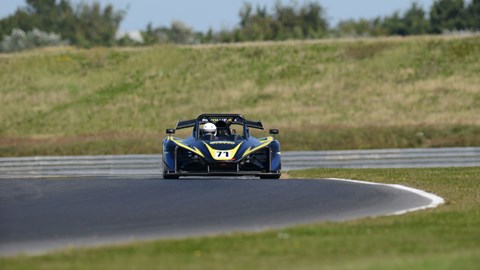
There’s now also power steering, with five adjustable levels. Turning wide, sticky slick tyres, squished into the track with downforce in the quick corners, you’d have to be very strong to go without it for the whole half-hour race. Even Hoy races with it switched on, and he lifts weights for fun.
I cross the line seconds before the chequered flag falls, giving me one more lap. A few corners in, it doesn’t feel like it’s a particularly good one but I remember something Chris mentioned earlier: at the velodrome, he could always feel, within a fraction of a second, the time he’d achieved as he crossed the line, but in a car, it can be harder to tell. Sometimes you feel you’re on a great lap but it’s actually slower; sometimes what feels like an average lap can be a really quick one. I keep pushing and to my surprise and delight it’s my best lap of the session. Never give up on a lap, seems to be the moral of the story.
I’m fourth overall and second on the grid in the Revolution Trophy class, alongside Danish racing driver Morten Dons. My cause has been helped slightly by rapid Revolution development driver James Abbott running out of fuel but, hey, I’ll take it. Chris has had a good run too, to P4 in the Revolution class.
Race One
I notice Hoy is one of the first drivers to get ready. While others in the assembly area mill around chatting, he’s belted in, mentally preparing. There’s no missing the bright red and yellow car he’s in: it’s a BMW-style Art Car, created in a competition Revolution opened to the public to design its livery.
Rolling start: we’re led by a pace car, which peels off into the pits, then it’s a case of maintaining position, watching the lights, and pinning the throttle the instant they change.
Morten Dons alongside me is unexpectedly cautious into Turn One. I stick to the outside line and, to my surprise, emerge leading the Revolutions. (The Jenvey and Radical prototypes that shared the front row are streaking ahead, but neither will last the race.) My mirrors are filled with Dons and James Abbott, battling and swapping places behind me. I fully expect either of them to find a way past at any moment but lead the race until lap five, when Dons dives down my inside under braking from a long way back for the tight Oggies corner. I’ve already begun turning in, and his car brushes mine as he squeezes through, Abbott following right on his tail.

I settle into a quiet third place, which becomes second when Dons has to retire – it turns out his steering arm eventually broke after the contact.
Approaching the fast right-hander onto the back straight, I see a brightly coloured car, a long way off the road against the barrier. It’s Chris. At first I assume he’s broken down and parked the car by a marshal post. Then the next lap, I take a second look. There’s something about the angle of the car, and its proximity to the barrier that doesn’t look good. Next lap round I can see Hoy stood on the other side of the barrier so at least he’s okay.
I cross the line in second place overall. Maybe it would have been P3 had Dons not had the steering issue, but I’m still chuffed.

I find Chris after the race to ask what happened: his throttle had stuck open. ‘Accelerating at full pelt towards the barrier – it’s not a nice feeling. I wouldn’t wish it on anyone,’ he says. ‘My first instinct was to push the clutch in – but you brake with your left foot in these cars, and as soon as I lifted my foot from the brake pedal, it accelerated. So I tried to cross my right foot over onto the clutch pedal but the barrier was coming up fast, and the only thing for it was to spin the car sideways, take a deep breath to fill my lungs with air, and brace for it. Like playing rugby – drop a shoulder, and go in…’
It was a big impact. A big rock resting against the other side of the barrier was thrown some distance away. The crash has cracked the gearbox casing, and the mounts to the seat. It’s a good job he’s made out of strong stuff. ‘I’m going to be sore tomorrow. At least it proves how safe the Revolution’s structure is,’ Chris says.
To enable Chris to compete in Race Two, James Abbott sits the race out and Chris swaps into his car. ‘Part of me almost didn’t want to go back out again,’ he says, over a coffee, ‘but I thought, it’s best to get back on the horse.’
Coffee – cyclists famously love their caffeine. Ford’s Le Mans drivers aren’t allowed to touch caffeine for weeks before the race, and Lando Norris is among several racers who never drink coffee. What’s Chris’s take? ‘I think it’s best to do what makes you feel comfortable. I drink about three strong cups of coffee on a normal day so I have quite a high tolerance, but I’d never drink a coffee to gee myself up before getting in the car, for example.’
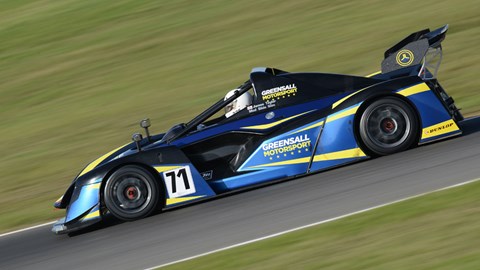
Does the same go for food? ‘Nutrition for motorsport is a much more relaxed approach than for cycling. You can’t always bring food with you, so it’s best to try and choose stuff that doesn’t give you a sudden spike of energy; stuff with a low glycaemic index.’
It’s amazing how far adrenaline can take you, though, Chris says. ‘Even at Le Mans in the dead of night, when you’ve had half an hour’s sleep and you’re so tired it feels as if the room’s rolling around like you’re on a ship – you wouldn’t get in a road car to drive to the shops – that can last right up to 10 minutes before getting in the car. Then you hear the engineer’s voice on the radio saying, “okay, your teammate’s coming in to pit shortly,” and suddenly Fight or Flight kicks in. You have that feeling of absolute alertness.’

‘The other thing I honestly believe is, if you go into a race feeling negative, it turns out negatively. You’ve got to free yourself to recognise you’re thinking that way – choose to remind yourself you’re doing something you love.
‘It’s the “chimp” part of your brain bargaining with you. It’s thinking, “I don’t want to do this.” And you can just kill it with logic – think of the reasons why it can go well. You can apply it to anything in life – public speaking, making a speech at a wedding, an important meeting…’
Race 2
To the important meeting of the second and final race of the day. This time I’m squeezed towards the grass on the run to the first corner and need to lift out of the throttle. Another Revolution driver, Richard Wells, nips through. A few corners later, he’s a little early on the brakes into Oggies, a gap opens… Should I go for it? Argh… Yes, go on… I dive for the inside, but in the moment it’s taken for me to think about it, the gap’s begun to narrow, and we touch, in almost a carbon copy of the Dons/Taylor contact in race one. The contact’s just firm enough for Richard to be sent wide, and as I slide out of the corner, in my mirrors I can see Chris and another car get ahead of him.
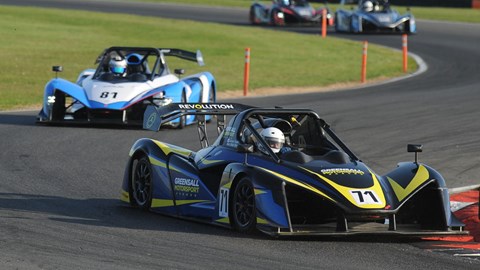
It was entirely unintentional contact, but I feel terrible. Like Hoy says, you want to win, but you want to do it in the right way. Only thing for it is to heed his other advice – forget mistakes, put them in the past, concentrate – and actually make some ground on the leading Dons. My luck’s about to run out though. Shifting down through the gears for the final corner at the end of lap two, the gearbox hits a false neutral, I pull the shift paddle to try and regain drive and it reengages first gear suddenly, locking the rears. It’s like pulling the handbrake on. I’m facing backwards, and Chris flashes by. Since the field’s still bunched together, I have to wait for all the other Revolutions to come past before it’s safe to turn around.
I’m at the back of the pack, but that also means the pressure’s off. The sun is starting to sink in an orange-tinted sky, the gearbox gremlin has vanished and I just enjoy driving the Revolution about as fast as I dare. In the fast corners, trusting the downforce, it’s mighty. Even at Snetterton’s hairpins, you can feel the wings and underbody surfaces working, enabling you to turn in at speeds that would see many racing cars running straight on.
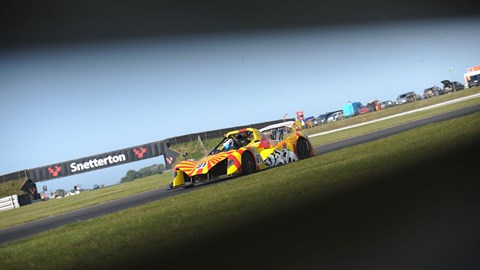
‘It’s a fun car to drive, and it doesn’t flatter you,’ is Hoy’s verdict. ‘It’s more exciting than a GT3 car – you don’t want to be driven round by a set of electronics. I think it’s more fun than an LMP3 car.’
I’m having a ball, and before too long I’ve overtaken my way back up to P4 overall, on the back of Wells in third. I still feel overwhelmingly guilty about the contact on the opening lap, and don’t dare have another go at out-braking him. He doesn’t make any mistakes and I follow him over the line, two tenths off the podium.
On its second step is Chris, who had an untroubled run to the end of the race, won by Dons. I’m genuinely delighted for him, just as he seems genuinely disappointed on my behalf.
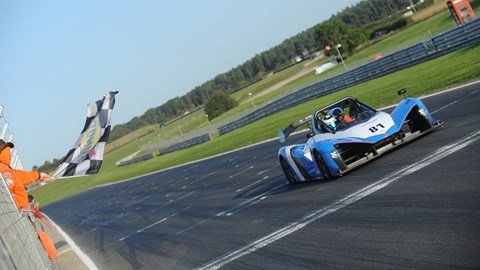
I leave Snetterton feeling I’ve learned a lot, not only from the experience of driving the Revolution again, but also about mindset, both in racing and for life’s challenges in general.
‘Part of focus is displacing negative thoughts or anything that can distract you,’ Hoy says. ‘I’m a firm believer that if you think you’re going to have a bad race, more often than not, you will, and vice versa.
‘It’s about taking it all in, and enjoying it. Even if you only get one lap and the car breaks, you’re still doing something that other people would love to do. And when you enjoy stuff, you tend to do it better.’
With thanks to Revolution Race Cars, the Sports Prototype Cup, Greensall Motorsport racing team, and photography by Oliver Read.
(Incidentally, I can vouch for Greensall Motorsports mechanical skills not only in setting up and looking after a very rapid race car but also fixing my road car, which A) boiled its coolant just inside the circuit gates, and B) wouldn’t start to get me home again. Sometimes it’s good to be brought back down to earth.)
Chris Hoy takes the CAR Inquisition: five questions only we would ask
Tell us about your first car…
A Citroen Xantia diesel. It was on 130,000 miles when I got it, and I used to travel from Edinburgh to Manchester in it when I started training there at the velodrome. It had air suspension that would suddenly drop, so there was this constant fear of breaking down.
I was always making a mental note of the emergency telephone points, in the days before mobile phones…
What’s the best thing you’ve done in a car?
I’ve been very lucky. Driving Colin McRae’s car with his dad in the passenger seat; driving a Dakar car in Morocco; but overall I’d have to say pulling out of the pit lane at Le Mans at night and going down the Mulsanne Straight. It has to be that.
Supercar or classic?
It’s a hard decision, because I’ve raced historic cars and I love the charm of the old cars. When you see someone in a classic car you give them a thumbs up – you don’t always get a thumbs up if you’re in a supercar…! I guess something like a Singer Porsche would be the perfect blend of both.
What achievement makes you most proud?
I think it is the Olympic medals – but I like to think I did it the right way. I’ve always tried to be a good competitor. Obviously you want to win, but you do it the right way, and follow all the rules. Following rules isn’t necessarily seen as an attractive quality in life today but it’s always been important to me.
Tell us about a time you screwed up…
I’ve just finished a book called ‘Be Amazing’ for kids aged nine and up, about how to get the most out of the themselves and to be the best you can be. In that book, I say everybody fails. If you’re not failing, you’re not challenging yourself enough. You learn and take the mistakes and use them as fuel going forwards. You don’t compare yourself to others, you compare yourself to your previous best.
But if I was going to choose a time – crashing at the 2014 Goodwood Festival of Speed, by a country mile. Because it was so public, and it was at the stage where I was still new to the sport. It still haunts me now…